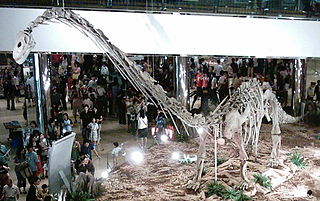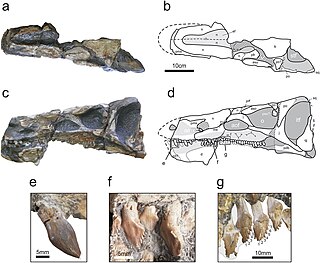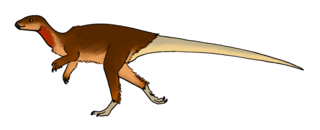
Xuanhanosaurus is a genus of theropod dinosaur that lived during the Middle Jurassic (Bathonian) of the Sichuan Basin, China, around 166.0 million years ago. This Taxon represents one of the various Carnosaurian taxa found on the Middle Jurassic of the region, uncovered on the Lower Shaximiao Formation. Although it has been known for more than 40 years, this taxon has been the subject of very few studies, although most seem to agree that it is a Tetanuran, possibly a basal Allosauroid, highlighting the fact that it has a vestigial fourth metacarpal.

Omeisaurus is a genus of sauropod dinosaur from the Middle Jurassic Period of what is now China. Its name comes from Mount Emei, where it was discovered in the lower Shaximiao Formation of Sichuan Province.
Bashunosaurus is a genus of potentially macronarian sauropod dinosaur from the Middle Jurassic Shaximiao Formation of Kaijiang, China. The type and only species is Bashunosaurus kaijiangensis.

Gigantspinosaurus is a genus of herbivorous ornithischian dinosaur from the Late Jurassic. It was a stegosaur found in China.

Nanosaurus is the name given to a genus of neornithischian dinosaur that lived about 155 to 148 million years ago, during the Late Jurassic-age. Its fossils are known from the Morrison Formation of the south-western United States. The type and only species, Nanosaurus agilis, was described and named by Othniel Charles Marsh in 1877. The taxon has a complicated taxonomic history, largely the work of Marsh and Peter M. Galton, involving the genera Laosaurus, Hallopus, Drinker, Othnielia, and Othnielosaurus, the latter three now being considered to be synonyms of Nanosaurus. It had historically been classified as a hypsilophodont or fabrosaur, types of generalized small bipedal herbivore, but more recent research has abandoned these groupings as paraphyletic and Nanosaurus is today considered a basal member of Neornithischia.

Poekilopleuron is a genus of tetanuran dinosaur, which lived during the middle Bathonian of the Jurassic, about 168 to 166 million years ago. The genus has been used under many different spelling variants, although only one, Poekilopleuron, is valid. The type species is P. bucklandii, named after William Buckland, and many junior synonyms of it have also been erected. Few material is currently known, as the holotype was destroyed in World War II, although many casts of the material still exist.

The Shaximiao Formation is a Middle to Late Jurassic aged geological formation in Sichuan, China, most notable for the wealth of dinosaurs fossils that have been excavated from its strata. The Shaximiao Formation is exposed in and around the small township of Dashanpu, situated seven kilometres north-east from Sichuan's third largest city, Zigong, in the Da'an District.
The Ziliujing Formation is a geological formation in China, It is Early Jurassic in age. It is part of the stratigraphy of the Sichuan Basin. The dinosaur Gongxianosaurus and indeterminate theropod material are known from the Dongyuemiao Member of the formation, as well as dinosaur footprints, Zizhongosaurus and indeterminate prosauropods from the Da'anzhai Member. The basal sauropod Sanpasaurus is known from the Maanshan Member. An unnamed stegosaur and the pliosauroid plesiosaur Sinopliosaurus are also known from this formation but they were found an indeterminate member. An unnamed teleosaurid known from a complete skull has also been found in the formation, pending a formal description. The deposition environment during the Da'anzhai Member in the lower Toarcian is thought to have been that of a giant freshwater lake encompassing the whole of the Sichuan basin, around 3 times larger than Lake Superior, coeval with the Toarcian Oceanic Anoxic Event around 183 Ma.
The Tuchengzi Formation is a geological formation in China whose strata span the Tithonian to Berriasian ages. Dinosaur fossils, particularly footprints, have been found from the formation.
The Zhenzhuchong Formation is an Early Jurassic geologic formation in China. Plesiosaur remains are among the fossils that have been recovered from its strata. Remains of the prosauropod Lufengosaurus huenei have been recovered from this formation As well as dinosaur footprints.
Protoxinjiangchelys is an extinct genus of xinjiangchelyid turtle known from the Early to Late Jurassic of China. It is known from the single species P. salis, which was named and described in 2012. It contains only the holotype, ZDM 3009, which consists of a complete shell with an articulated carapace and a complete plastron and possibly another, older specimen.
The Zhiluo Formation is a geological formation in China, it is also alternatively considered a geological group under the name Zhiluo Group. It dates to the Middle Jurassic. It consists of sandstone, mudstone and siltstone of varying colours. It has received scientific attention for its uranium ore bodies present in the lower part of the formation. Fossil theropod tracks have been reported from the formation. These were described from two footprints found in Jiaoping Coal Mine by C. C. Young in 1966 as Shensipus tungchuanensis. These were in 2015 suggested to belong to Anomoepus. The dinosaur Lingwulong has been suggested to have come from the strata of this formation, previously having been attributed to the underlying Yanan Formation.

Isaberrysaura is a genus of stegosaurian ornithischian dinosaur from the Middle Jurassic Los Molles Formation of Patagonia, Argentina. The genus contains a single species, I. mollensis, described by Salgado et al. in 2017 from a single specimen. Although initially classified as a basal neornithischian, subsequent analysis has allied it with the Stegosauria; the morphology of its skull resembles those of other members of the group.

Lingwulong is a genus of dicraeosaurid sauropod dinosaur from the Middle Jurassic of what is now Lingwu, Yinchuan, Ningxia, China. The type and only species is L. shenqi, known from several partial skeletons. It is the earliest-aged neosauropod ever discovered, as well as the only definite diplodocoid from east Asia.
The Yanan Formation, alternatively spelled the Yan'an Formation, is a geological formation in China, it is also alternatively considered a group. The age of the formation is uncertain, with estimates ranging from Toarcian to Bajocian. It is divided up into 5 members, with the designation of Y1 through Y5. Y2, Y3 and Y4 are predominantly dark shales, while Y1 and Y5 are composed of sandstones, coal beds and interbedded mudstones. The depositional environment at the time was when the Ordos Basin formed a large inland lake, surrounded by floodplains. The dark shales have been explored for the potential of producing shale gas. The coal has also been explored for the production of coalbed methane. The formation is also notable for its fossil content, with dinosaur footprints having been found in the formation. The dinosaur Lingwulong was formerly thought to have been found in this formation, but the strata was later attributed to the overlying Zhiluo Formation.

Sanxiasaurus is a genus of neornithischian dinosaur from the Middle Jurassic Xintiangou Formation in the Chongqing Municipality of China. The type and only species is S. modaoxiensis. The holotype is a partial postcranial skeleton consisting of "55 bones including two cervical vertebrae, 11 dorsal vertebrae, 4 sacral vertebrae, 18 caudal vertebrae, both humeri, radii and ulnas, partial right ilium, partial right ischium, both femora and tibiae, left fibula, 3 metatarsi and 4 phalanges." In a phylogenetic analysis, it was found to be a basal neornithischian, more derived than Lesothosaurus and less derived than Hexinlusaurus.
Yunyangosaurus is a genus of possible megalosauroid dinosaur from the Xintiangou Formation in Chongqing, China. The type and only species is Yunyangosaurus puanensis. The name was first published in the 2019 SVP abstract book by Dai (2019) before it was formally described by Dai et al. (2020).
Bashanosaurus is a genus of stegosaur dinosaur recovered from the Bajocian -aged Shaximiao Formation of Yunyang, Chongqing, China. The type species is Bashanosaurus primitivus. It is one of the basalmost stegosaurs and is also the oldest known stegosaur, supplanting the previous oldest known stegosaur, Adratiklit, which is roughly one million years younger.








